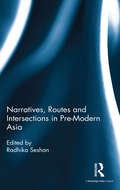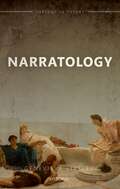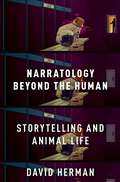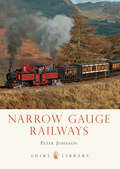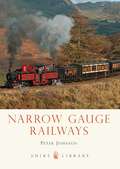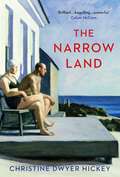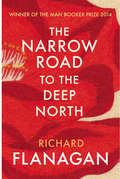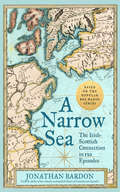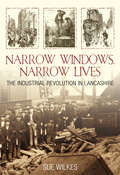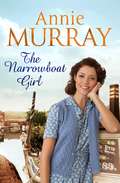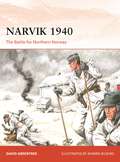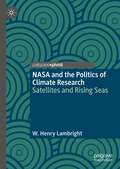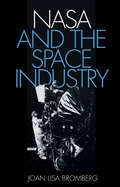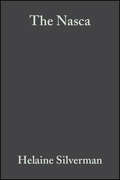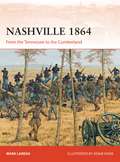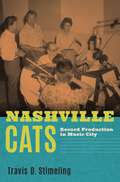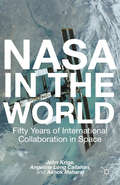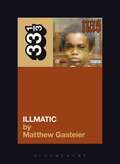- Table View
- List View
Narratives, Routes and Intersections in Pre-Modern Asia
by Radhika SeshanThis book traces connections in pre-modern Asia by looking at different worlds across geography, history and society. It examines how regions were connected by people, families, trade and politics as well as how they were maintained and remembered. The volume analyses these intersections of memory and narrative, of people and places and the routes that took people to these places, using a variety of sources. It also studies whether these intersections remain in later and present times, and their larger impact on our understanding of history. The narratives cover several journeys drawn from archaeology, texts and cultural imagination: trade routes, marts, fairs, forts, religious pilgrimages, inscriptions, calligraphy and coinages spanning diverse regions, including India–Tibet–British forays, India–Malay intersections, corporate enterprise in the Indian Ocean, impacts of slave trade in Southeast Asia shaped by the Dutch East India company, movements and migrations around Indo-Iranian borderlands and those in western and southern India. The book will greatly interest scholars and researchers of history and archaeology, cultural studies and literature.
Narratives, Routes and Intersections in Pre-Modern Asia
by Radhika SeshanThis book traces connections in pre-modern Asia by looking at different worlds across geography, history and society. It examines how regions were connected by people, families, trade and politics as well as how they were maintained and remembered. The volume analyses these intersections of memory and narrative, of people and places and the routes that took people to these places, using a variety of sources. It also studies whether these intersections remain in later and present times, and their larger impact on our understanding of history. The narratives cover several journeys drawn from archaeology, texts and cultural imagination: trade routes, marts, fairs, forts, religious pilgrimages, inscriptions, calligraphy and coinages spanning diverse regions, including India–Tibet–British forays, India–Malay intersections, corporate enterprise in the Indian Ocean, impacts of slave trade in Southeast Asia shaped by the Dutch East India company, movements and migrations around Indo-Iranian borderlands and those in western and southern India. The book will greatly interest scholars and researchers of history and archaeology, cultural studies and literature.
Narratologie und Geschichte: Eine Analyse schottischer Historiografie am Beispiel des »Scotichronicon« und des »Bruce« (Mainzer Historische Kulturwissenschaften #44)
by Davina HachgeneiAm Beispiel der spätmittelalterlichen schottischen Historiografie entwickelt Davina Hachgenei einen neuen methodischen Zugriff für die Geschichtswissenschaften: Sie wendet eine narratologische Methode auf historische Quellen - The Bruce und Scotichronicon - an und ergänzt damit die klassische Hermeneutik um einen analytischen Zugang. Gleichzeitig kontextualisiert sie die theoretischen Grundlagen und trägt damit zur Neuausrichtung der narratologischen Theorie in der Kulturwissenschaft bei: eine Statusklärung der Narratologie als Theorie und Methode für die Geschichtswissenschaft.
Narratology
by Genevieve LiveleyThis volume explores the extraordinary contribution that classical poetics has made to twentieth and twenty-first century theories of narrative, aiming not to argue that modern narratologies simply present 'old wine in new wineskins', but rather to identify the diachronic affinities shared between ancient and modern stories about storytelling. By recognizing that modern narratologists bring a particular expertise to bear upon ancient literary theory, and by interrogating ancient and modern narratologies through the mutually imbricating dynamics of their reception, it seeks to arrive at a better understanding of both. Each chapter selects a key moment in the history of narratology on which to focus, providing an overview of significant phases before offering detailed analyses of core theories and texts, from the Russian formalists and Chicago school neo-Aristotelians, through the prestructuralists, structuralists, and poststructuralists, up to the latest unnatural and antimimetic narratologists. The reception history that thus unfolds offers some remarkable plot twists and yields valuable insights into the interpretation of some notoriously difficult ancient works. Plato in the Republic is unmasked as an unreliable narrator and theorist, while Aristotle's On Poets reveals a rare glimpse of the philosopher putting narrative theory into practice in the role of storyteller. Horace's Ars Poetica and the works of ancient scholia by critics and commentators evince a rhetorically conceived poetics and sophisticated reader-response-based narratology which indicate a keen interest in audience affect and cognition - anticipating the cognitive turn in narratology's most recent postclassical phase.
Narratology beyond the Human: Storytelling and Animal Life
by David HermanTo what extent, and in what manner, do storytelling practices accommodate nonhuman subjects and their modalities of experience, and how can contemporary narrative study shed light on interspecies interactions and entanglements? In Narratology beyond the Human, David Herman addresses these questions through a cross-disciplinary approach to post-Darwinian narratives concerned with animals and human-animal relationships. Herman considers the enabling and constraining effects of different narrative media, examining a range of fictional and nonfictional texts disseminated in print, comics and graphic novels, and film. In focusing on techniques such as the use of animal narrators, alternation between human and nonhuman perspectives, the embedding of stories within stories, and others, the book explores how specific strategies for portraying nonhuman agents both emerge from and contribute to broader attitudes toward animal life. Herman argues that existing frameworks for narrative inquiry must be modified to take into account how stories are interwoven with cultural ontologies, or understandings of what sorts of beings populate the world and how they relate to humans. Showing how questions of narrative bear on ideas of species difference and assumptions about animal minds, Narratology beyond the Human underscores our inextricable interconnectedness with other forms of creatural life and suggests that stories can be used to resituate imaginaries of human action in a more-than-human world.
Narratology beyond the Human: Storytelling and Animal Life
by David HermanTo what extent, and in what manner, do storytelling practices accommodate nonhuman subjects and their modalities of experience, and how can contemporary narrative study shed light on interspecies interactions and entanglements? In Narratology beyond the Human, David Herman addresses these questions through a cross-disciplinary approach to post-Darwinian narratives concerned with animals and human-animal relationships. Herman considers the enabling and constraining effects of different narrative media, examining a range of fictional and nonfictional texts disseminated in print, comics and graphic novels, and film. In focusing on techniques such as the use of animal narrators, alternation between human and nonhuman perspectives, the embedding of stories within stories, and others, the book explores how specific strategies for portraying nonhuman agents both emerge from and contribute to broader attitudes toward animal life. Herman argues that existing frameworks for narrative inquiry must be modified to take into account how stories are interwoven with cultural ontologies, or understandings of what sorts of beings populate the world and how they relate to humans. Showing how questions of narrative bear on ideas of species difference and assumptions about animal minds, Narratology beyond the Human underscores our inextricable interconnectedness with other forms of creatural life and suggests that stories can be used to resituate imaginaries of human action in a more-than-human world.
„Narren in Christo“: Jehovas Zeugen im literarischen Erinnerungsdiskurs Überlebender des Nationalsozialismus (Studien zu Literatur und Religion / Studies on Literature and Religion #5)
by Nathan SchmidtchenDie vorliegende Studie ist die erste, die den Erinnerungsspuren nachgeht, die Jehovas Zeugen (Bibelforscher) in den Erzähltexten Überlebender des Nationalsozialismus hinterlassen haben. Trotz unterschiedlicher Erinnerungskulturen und -interessen seitens der Autoren ergibt sich ein einheitliches und zugleich schillerndes Bild. Häufig nur Erzählobjekte ohne eigene Stimme, bleiben sie randständig, andersartig und widersprüchlich. Jehovas Zeugen faszinieren, befremden und stören. Als Heilige, Propheten, Märtyrer, Samariter und Sündenböcke stehen sie in der Nachfolge des Sohnes Gottes. Bezüge ergeben sich auch zur Figur des christlichen Narren: nicht von dieser Welt, der Welt des nationalsozialistischen Terrors, aber zugleich in ihr und gegen sie zeugend.
Narrow Gauge Railways (Shire Library #772)
by Peter JohnsonNarrow gauge railways, so well suited to difficult, mountainous terrain, were built in many of the UK's most scenic locations. Their genesis was in mines and quarries where they replaced manor horse-pulled wagons, but their adaptability meant that by the 1860s they were also carrying passengers, in some cases over quite considerable distances. Today a good proportion of all the important lines survive in the service of tourists, whose appreciation of the landscape, and the railways themselves, keep these relics of industrial Britain alive in all their variety. Peter Johnson has been researching and writing about narrow gauge lines for many years, and this is the perfect introduction to a rich and appealing corner of British railway history.
Narrow Gauge Railways (Shire Library)
by Peter JohnsonNarrow gauge railways, so well suited to difficult, mountainous terrain, were built in many of the UK's most scenic locations. Their genesis was in mines and quarries where they replaced manor horse-pulled wagons, but their adaptability meant that by the 1860s they were also carrying passengers, in some cases over quite considerable distances. Today a good proportion of all the important lines survive in the service of tourists, whose appreciation of the landscape, and the railways themselves, keep these relics of industrial Britain alive in all their variety. Peter Johnson has been researching and writing about narrow gauge lines for many years, and this is the perfect introduction to a rich and appealing corner of British railway history.
The Narrow Land: WINNER of the Walter Scott Historical Prize for Fiction 2020
by Christine Dwyer Hickey"A brilliant portrait... With a beguiling grace and a deceptive simplicity, Christine Dwyer Hickey reminds us that the past is never far away - rather, it constantly surrounds us, suspends us, haunts us." Colum McCann 1950: late summer season on Cape Cod. Michael, a ten-year-old boy, is spending the summer with Richie and his glamorous but troubled mother. Left to their own devices, the boys meet a couple living nearby - the artists Jo and Edward Hopper - and an unlikely friendship is forged.She, volatile, passionate and often irrational, suffers bouts of obsessive sexual jealousy. He, withdrawn and unwell, depressed by his inability to work, becomes besotted by Richie's frail and beautiful Aunt Katherine who has not long to live - an infatuation he shares with young Michael.A novel of loneliness and regret, the legacy of World War II and the ever-changing concept of the American Dream.
The Narrow Road to the Deep North: Discover the Booker prize-winning masterpiece
by Richard Flanagan***WINNER OF THE BOOKER PRIZE***There were for them only two sorts of men: the men who were on the Line, and the rest of humanity, who were not. In the despair of a Japanese POW camp on the Burma Death Railway, surgeon Dorrigo Evans is haunted by his love affair with his uncle's young wife two years earlier. Struggling to save the men under his command from starvation, from cholera, from beatings, he receives a letter that will change his life forever.This is a story about the many forms of love and death, of war and truth, as one man comes of age, prospers, only to discover all that he has lost.'Elegantly wrought, measured and without an ounce of melodrama, Flanagan's novel is nothing short of a masterpiece' Financial Times
A Narrow Sea: The Irish–Scottish Connection in 120 Episodes
by Jonathan BardonBased on the popular BBC Radio Ulster series of the same name, A Narrow Sea traces the epic sweep of Ireland’s relationship with Scotland, exploring the myriad connections, correlations, personalities and antagonisms that have, over the years, defined the relationship between these two spirited neighbours.Roving freely across the centuries, from the first migrations of the regions’ intrepid Mesolithic pioneers, to the grand colonial projects of the Vikings, Normans and Stuarts, this is the dramatic story of how one culture came to found two very different nations and, in doing so, project its influence as far afield as North America and Australasia.In 120 brief and accessible episodes, A Narrow Sea offers a stirring and panoramic view of a connection that has shaped the course of history on both sides of the narrow sea.
Narrow Windows, Narrow Lives: The Industrial Revolution in Lancashire
by Sue WilkesWorking families in Victorian Lancashire had few choices. Work; starve; or face the workhouse and the break up of their family. Narrow Windows, Narrow Lives recreates everyday life for textile workers, canal boat families, coalminers, metal workers navvies and glassblowers using contemporary eyewitness accounts and interviews. It depicts the dire state of towns and the dreadful hazards workers faced on a daily basis. Who was the ‘knocker-upper’? Why did families eat ‘tommyrot’? Why couldn’t ‘Lump Lad’ sleep soundly in his bed? Men, women and children endured incredibly long working hours in appalling conditions – but their toil helped make Britain ‘Great.’
The Narrowboat Girl: An Absorbing Tale Of Advneture And True Love (Soundings Ser.)
by Annie MurrayThe Narrowboat Girl by Annie Murray is the story of a young woman's search for freedom and happiness.Young Maryann Nelson is devastated at the loss of her beloved father. But worse is to come when her mother, Flo, sees an opportunity to better herself and her family in a marriage to the local undertaker, Norman Griffin. Though on the surface a caring family man, Norman is not at all what he seems, as Maryann and her sister Sal soon discover.Unable to turn to their unsympathetic mother for support, the girls are left alone with their harrowing secret. But for Sal it is too much to bear . . . The chance of a new life opens up for Maryann when she befriends Joel Bartholomew. Aboard his narrowboat, the Esther Jane, she finds herself falling in love with life on the canal as she is swept away from Birmingham and all her worries. Until Joel's feelings for Maryann begin to change, awakening all the old nightmares that she had thought were long buried, and in panic and confusion she takes flight . . . The Narrowboat Girl is followed by sequel, Water Gypsies.
Narvik 1940: The Battle for Northern Norway (Campaign)
by David GreentreeIn early 1940, a battle raged to control the ice-free, iron-ore port in northern Norway – with changing fortunes until the very end. This highly detailed book covers both the naval battles and the individual Norwegian, British, Polish, French and German units that fought the land campaign over northern Norway. Highly detailed maps guide you step by step through the events. Few other books on Narvik give you as much detail on the forces of the fighting five. From Gebirgsjägers to Guardsmen, Fallschirmjägers to Foreign Legionnaires, it offers you an impressive level of tactical detail, even down to company command, whilst also helping you understand the strategic confusion surrounding the whole Allied expedition to the north too. Among the naval clashes covered in this action-packed story are the destroyer battles in the fjords, the sinking of the aircraft carrier HMS Glorious and the roles the famous battlecruisers Scharnhorst and Gneisenau played in the fighting. No less dramatic are the land battles, which include amphibious landings, sabotage, commando raids, daring ski missions and a rare parachute insertion by Gebirgsjäger troops.
Narvik 1940: The Battle for Northern Norway (Campaign)
by David GreentreeIn early 1940, a battle raged to control the ice-free, iron-ore port in northern Norway – with changing fortunes until the very end. This highly detailed book covers both the naval battles and the individual Norwegian, British, Polish, French and German units that fought the land campaign over northern Norway. Highly detailed maps guide you step by step through the events. Few other books on Narvik give you as much detail on the forces of the fighting five. From Gebirgsjägers to Guardsmen, Fallschirmjägers to Foreign Legionnaires, it offers you an impressive level of tactical detail, even down to company command, whilst also helping you understand the strategic confusion surrounding the whole Allied expedition to the north too. Among the naval clashes covered in this action-packed story are the destroyer battles in the fjords, the sinking of the aircraft carrier HMS Glorious and the roles the famous battlecruisers Scharnhorst and Gneisenau played in the fighting. No less dramatic are the land battles, which include amphibious landings, sabotage, commando raids, daring ski missions and a rare parachute insertion by Gebirgsjäger troops.
NASA and the Politics of Climate Research: Satellites and Rising Seas (Palgrave Studies in the History of Science and Technology)
by W. Henry LambrightToday, there exists an integrated, large-scale satellite system to track sea-level rise, its speed, causes, and impacts. Building it was a struggle every step of the way. It was the most vivid and potentially consequential program within NASA’s larger Earth Science directorate. How did it happen? Who did what? Why? This book seeks to answer such questions. It goes back to the origins of NASA’s interest in the oceans in the 1960s and first true ocean satellite, Seasat, in 1978. After three months of operation, Seasat failed. But before it did, it showed how much satellites could tell about the ocean’s dynamics. In many ways, sea-level rise is the clearest and most understandable result of a warming planet.
NASA and the Space Industry (New Series in NASA History (PDF))
by Joan Lisa BrombergFew federal agencies have more extensive ties to the private sector than NASA. NASA's relationships with its many aerospace industry suppliers of rocket engines, computers, electronics, gauges, valves, O-rings, and other materials have often been described as "partnerships." These have produced a few memorable catastrophes, but mostly technical achievements of the highest order. Until now, no one has written extensively about them.In NASA and the Space Industry, Joan Lisa Bromberg explores how NASA's relationship with the private sector developed and how it works. She outlines the various kinds of expertise public and private sectors brought to the tasks NASA took on, describing how this division of labor changed over time. She explains why NASA sometimes encouraged and sometimes thwarted the privatization of space projects and describes the agency's role in the rise of such new space industries as launch vehicles and communications satellites.
The Nasca (Peoples of America)
by Helaine Silverman Donald ProulxThis well-illustrated, concise text will serve as a benchmark study of the Nasca people and culture for years to come.
Nashville 1864: From The Tennessee To The Cumberland (Campaign Ser. #314)
by Adam Hook Mark LardIn September 1864, the Confederate army abandoned Atlanta and were on the verge of being driven out of the critical state of Tennessee. In an attempt to regain the initiative, John Bell Hood launched an attack on Union General Sherman's supply lines, before pushing north in an attempt to retake Tennessee's capital Nashville. This fully illustrated book examines the three-month campaign that followed, one that confounded the expectations of both sides. Instead of fighting Sherman's Union Army of the Tennessee, the Confederates found themselves fighting an older and more traditional enemy: the Army of the Cumberland. This was led by George R. Thomas, an unflappable general temperamentally different than either the mercurial Hood or Sherman. The resulting campaign was both critical and ignored, despite the fact that for eleven weeks the fate of the Civil War was held in the balance.
Nashville 1864: From the Tennessee to the Cumberland (Campaign)
by Adam Hook Mark Lardas Nikolai BogdanovicIn September 1864, the Confederate army abandoned Atlanta and were on the verge of being driven out of the critical state of Tennessee. In an attempt to regain the initiative, John Bell Hood launched an attack on Union General Sherman's supply lines, before pushing north in an attempt to retake Tennessee's capital Nashville. This fully illustrated book examines the three-month campaign that followed, one that confounded the expectations of both sides. Instead of fighting Sherman's Union Army of the Tennessee, the Confederates found themselves fighting an older and more traditional enemy: the Army of the Cumberland. This was led by George R. Thomas, an unflappable general temperamentally different than either the mercurial Hood or Sherman. The resulting campaign was both critical and ignored, despite the fact that for eleven weeks the fate of the Civil War was held in the balance.
Nashville Cats: Record Production in Music City
by Travis D. StimelingThe Nashville Cats bounced from studio to studio along the city's Music Row, delivering instrumental backing tracks for countless recordings throughout the mid-20th century. Music industry titans like Chet Atkins, Anita Kerr, and Charlie McCoy were among this group of extraordinarily versatile session musicians who defined the era of the "Nashville Sound," and helped establish the city of Nashville as the renowned hub of the record industry it is today. Nashville Cats: Record Production in Music City is the first account of these talented musicians and the behind-the-scenes role they played to shape the sounds of country music. Many of the genre's most celebrated artists-Patsy Cline, Jim Reeves, Floyd Cramer, and others immortalized in the Country Music Hall of Fame and musicians from outside the genre's ranks, like Bob Dylan and Leonard Cohen, heard the call of the Nashville Sound and followed it to the city's studios, recording song after song that resonated with the brilliance of the Cats. Author Travis D. Stimeling investigates how the Nashville system came to be, how musicians worked within it, and how the desires of an ever-growing and diversifying audience affected the practices of record production. Drawing on a rich array of recently uncovered primary sources and original oral histories,Âinterviews with key players, and close exploration of hit songs, Nashville Cats brings us back into the studios of this famous era, right alongside the remarkable musicians who made it happen.
Nashville Cats: Record Production in Music City
by Travis D. StimelingThe Nashville Cats bounced from studio to studio along the city's Music Row, delivering instrumental backing tracks for countless recordings throughout the mid-20th century. Music industry titans like Chet Atkins, Anita Kerr, and Charlie McCoy were among this group of extraordinarily versatile session musicians who defined the era of the "Nashville Sound," and helped establish the city of Nashville as the renowned hub of the record industry it is today. Nashville Cats: Record Production in Music City is the first account of these talented musicians and the behind-the-scenes role they played to shape the sounds of country music. Many of the genre's most celebrated artists-Patsy Cline, Jim Reeves, Floyd Cramer, and others immortalized in the Country Music Hall of Fame and musicians from outside the genre's ranks, like Bob Dylan and Leonard Cohen, heard the call of the Nashville Sound and followed it to the city's studios, recording song after song that resonated with the brilliance of the Cats. Author Travis D. Stimeling investigates how the Nashville system came to be, how musicians worked within it, and how the desires of an ever-growing and diversifying audience affected the practices of record production. Drawing on a rich array of recently uncovered primary sources and original oral histories,Âinterviews with key players, and close exploration of hit songs, Nashville Cats brings us back into the studios of this famous era, right alongside the remarkable musicians who made it happen.
NASA in the World: Fifty Years of International Collaboration in Space (Palgrave Studies in the History of Science and Technology)
by John Krige Ashok Maharaj Angela Long CallahanSince its inception, NASA has participated in over 4,000 international projects, yet historians have almost entirely neglected this remarkable aspect of the agency's work. This groundbreaking work is the first to trace NASA's history in a truly international context, drawing on unprecedented access to agency archives and personnel.
Nas's Illmatic (33 1/3)
by Matthew GasteierContradiction, the yin and the yang, the simultaneous existence of two competing realities, and the larger than life persona that depicts populist realism are at the core of Nas's debut album, Illmatic. Yet Nas's identity -as an inner-city youth, a child of hip-hop, and a Black American - predicts those philosophical quandaries as much as it does its brazen ambition. Partly because of that recklessly broad scope, the artistic impact of Illmatic was massive. The record finds its place in the greatest transition in hip hop up to that point, the spot where the streets and the charts collided.
